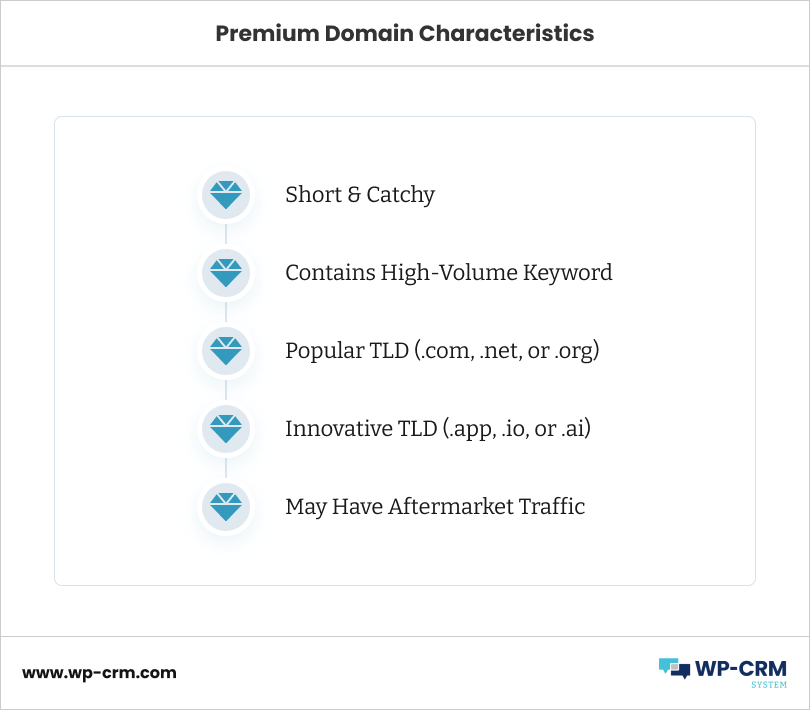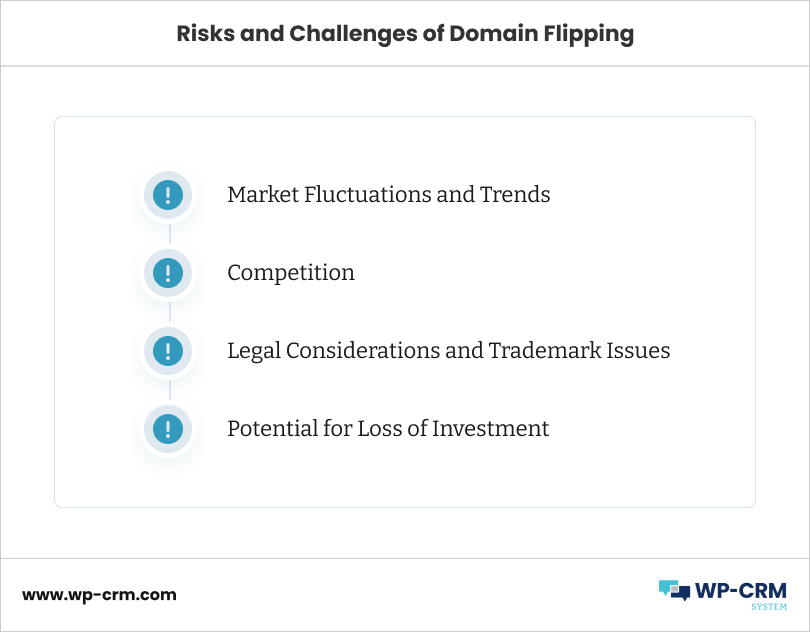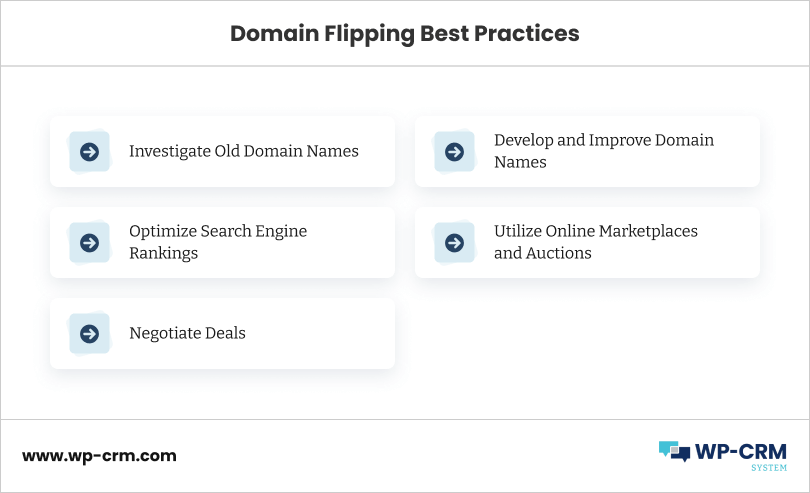What Is Domain Flipping And How To Do It Right
Domain flipping, a practice also known as domain speculation, involves buying and selling domain names for profit. It’s akin to virtual real estate investment, where the digital landscape holds the key to high returns. Understanding the nuances of domain flipping and executing it correctly can unlock a world of financial opportunity in the vast expanse of the internet.
In today’s digital age, where online presence is paramount for businesses and individuals alike, domain names serve as virtual addresses, embodying brands, ideas, and identities. Consequently, the demand for premium domain names with memorable, brandable, and keyword-rich attributes continues to soar. This demand creates an ecosystem ripe for entrepreneurial endeavors in domain flipping.
However, the importance of comprehending the domain flipping landscape cannot be overstated. Without a solid understanding of market trends, valuation principles, and effective marketing strategies, navigating the domain market can be akin to sailing in uncharted waters. Therefore, embarking on the journey of domain flipping demands meticulous research, strategic planning, and a keen eye for emerging opportunities.
What Is Domain Flipping?
Domain flipping, often referred to as domain speculation, is the art of buying and selling domain names with the primary objective of generating profit.
Domain flipping is a lucrative business strategy that involves the purchase and resale of domain names to generate profit. The process entails researching and acquiring domain names at a low cost, with the intention of selling them at a higher price in the future. The objective is to pinpoint domain names that have the potential for significant value appreciation and match them with prospective buyers who require them for their specific needs.
Professionals engaged in domain flipping typically conduct market research, analyze trends, and explore various industries to uncover domain names with growth potential. Once acquired, these domain names may be held for a period, allowing their value to appreciate before being sold to interested parties.
The process begins with acquiring domain names that possess inherent value or have a potential in the future. These domain names may feature generic keywords, premium terms, or have strong brand potential. Once acquired, domain flippers may choose to hold onto the domains for strategic reasons, such as waiting for market demand to increase or developing the domain to enhance its value further. Alternatively, they may opt to actively market and sell the domain name to potential buyers.
The domain market is dynamic and multifaceted, influenced by various factors such as industry trends, technological advancements, and cultural shifts.
Premium domain names, which are short, memorable, and keyword-rich, are often in high demand due to their perceived value in branding, marketing, and SEO. Additionally, domains that align with popular niches or emerging industries tend to command higher prices as businesses vie for a competitive edge in the online space.

Benefits of Domain Flipping
Domain flipping offers a multitude of benefits for entrepreneurs seeking to capitalize on opportunities in the digital marketplace:
Financial Gains
One of the most appealing aspects of domain flipping is its potential for significant financial returns. Successful flips can result in substantial profits, with domain names often selling for amounts ranging from hundreds to millions of dollars.
By identifying undervalued domain names, strategically enhancing their market appeal, and selling them at a higher price, domain flippers can generate lucrative returns on their investments.
The ability to leverage creativity, market insight, and negotiation skills can further amplify profit margins in this dynamic industry.
Low Initial Investment
Unlike traditional business ventures that may require substantial capital investment, domain flipping offers a low barrier to entry.
The initial investment required to acquire domain names is relatively minimal compared to other business opportunities, making it accessible to entrepreneurs of varying financial backgrounds.
This affordability enables individuals to enter the domain flipping market with ease, regardless of their financial resources, and potentially reap significant rewards with strategic investment and diligent execution.
Flexible Work Environment
Domain flipping provides a flexible work environment that empowers entrepreneurs to manage their time and resources autonomously.
With the freedom to work from anywhere with an internet connection, domain flippers can create their own schedules, balance personal and professional commitments, and pursue their entrepreneurial aspirations on their own terms.
This flexibility is particularly attractive to digital nomads, remote workers, and individuals seeking a lifestyle characterized by location independence and work-life balance.
Ability to Learn and Grow Within the Industry
Engaging in domain flipping offers valuable opportunities for learning and professional growth within the industry. Aspiring domain flippers have the chance to expand their knowledge of market trends, domain valuation principles, negotiation strategies, and online marketing techniques.
Moreover, navigating the dynamic landscape of domain flipping fosters adaptability, resilience, and innovation, equipping individuals with transferable skills applicable to various entrepreneurial endeavors.
Whether through successful flips, networking with industry professionals, or continuous self-education, domain flippers can continuously evolve and thrive in the ever-changing digital marketplace.
High Demand for Domains
The demand for quality domains is definitely on the rise. First, we had the pandemic when most people’s professional life as well as services like dining, video sharing and virtual touring transferred into their online form.
Then, we have ChatGPT making content creation and SEO a breeze. According to Verisign, 354 domains were registered in 2023, compared to 3.5 billion less just the year before. In fact, 28,800 new websites are built daily, which means 1,200 per hour!
Risks and Challenges of Domain Flipping

While domain flipping offers promising opportunities for profit and growth, it is not without its risks and challenges. Understanding and mitigating these factors is essential for success in the domain flipping industry:
Market Fluctuations and Trends
The domain market is subject to fluctuations influenced by various factors such as industry trends, consumer behavior, and technological advancements. Changes in market demand and preferences can impact the value of domain names, leading to fluctuations in prices and demand.
On top of that, emerging trends and innovations may render certain domain names obsolete or less valuable over time. Therefore, domain flippers must stay vigilant, conduct thorough market research, and adapt their strategies to capitalize on evolving market trends and opportunities.
Competition
As the popularity of domain flipping grows, so does the level of competition within the industry. Competing against seasoned domain investors, domain brokers, and automated domain acquisition tools can make it challenging to acquire desirable domain names at favorable prices.
In addition, increased competition may lead to bidding wars and inflated prices in domain auctions, making it harder for novice flippers to secure profitable deals. To thrive in a competitive market, domain flippers must differentiate themselves, cultivate relationships with domain brokers, and develop innovative acquisition strategies.
Legal Considerations and Trademark Issues
Navigating legal considerations and trademark issues is paramount in domain flipping to avoid potential legal disputes and financial liabilities. Domain names that infringe on existing trademarks or intellectual property rights can result in costly legal battles and domain name disputes.
Moreover, regulatory changes and jurisdictional differences may impact the legality of certain domain flipping practices, such as domain squatting or cybersquatting. Therefore, conducting comprehensive due diligence, obtaining legal advice when necessary, and adhering to ethical domain acquisition practices are essential to mitigate legal risks and safeguard investments.
Potential for Loss of Investment
Despite careful planning and research, there is always the risk of loss of investment in domain flipping. Not all acquired domain names will appreciate in value or attract buyers, and some may even depreciate over time. Factors such as market saturation, changing consumer preferences, and technological disruptions can adversely affect the resale value of domain names.
Also, unforeseen circumstances such as economic downturns or global crises may impact the demand for domain names and diminish profitability. To minimize the risk of loss, domain flippers should diversify their portfolio, set realistic expectations, and maintain financial discipline when acquiring domain assets.
How To Get Started with Domain Flipping
Embarking on a successful domain flipping venture requires careful planning, strategic decision-making, and a solid understanding of the market dynamics. Here’s a comprehensive guide to getting started with domain flipping:
Choose a Profitable Niche
Selecting the right niche is crucial for success in domain flipping. Focus on niches with high demand, potential for growth, and strong market relevance. Conduct market research to identify emerging trends, popular industries, and niche markets with untapped potential.
Consider factors such as consumer preferences, keyword popularity, and competitive landscape when choosing a niche. By targeting a specific niche, you can streamline your efforts, optimize your marketing strategy, and maximize your chances of success in domain flipping.
Research Domain Names and Their Value
Thorough research is essential when evaluating domain names and their potential value. Use domain appraisal tools, market analysis reports, and historical sales data to assess the value of domain names accurately. Factors such as domain length, keyword relevance, brandability, and extension type can influence the value of a domain name.
Additionally, consider the demand for specific keywords or industry-specific terms within your chosen niche. By conducting comprehensive research, you can identify undervalued domain names with significant resale potential and avoid overpaying for domain assets.

Purchase and Set a Budget
Once you’ve identified promising domain names, it’s time to acquire them strategically. Set a realistic budget based on your financial resources, risk tolerance, and investment goals. Determine the maximum amount you’re willing to spend on acquiring domain names, taking into account potential renewal fees and additional expenses.
Explore various acquisition channels, including domain marketplaces, auctions, and private sales. Negotiate prices diligently and leverage your research findings to justify your offers. When purchasing domain names, prioritize quality over quantity and focus on acquiring valuable assets with long-term potential.
Domain Flipping Best Practices

Mastering domain flipping requires a combination of strategic planning, creative thinking, and effective execution. By adopting best practices tailored to the dynamic domain market, aspiring domain flippers can maximize their chances of success and profitability. Here are key strategies to consider:
1. Investigate Old Domain Names
Investigating old domain names entails delving into various online tools and techniques to unearth valuable historical data about a website’s past.
Utilizing services like the Wayback Machine allows users to retrieve snapshots of web pages from the past, providing insights into the evolution of a website’s content, design, and functionality over time. This historical web data can reveal crucial information about the website’s previous owners, purposes, and changes undergone throughout its existence.
Domain Name WHOIS lookup tools enable individuals to uncover ownership details and registration history associated with a domain name. By accessing historical WHOIS records through services like Domaintools and Whoisology, researchers can trace changes in ownership, contact information, and registration dates, shedding light on the domain’s journey through different hands over the years.
Website hosting services play a pivotal role in identifying the current host of a domain, while reverse IP searches offer insights into other websites sharing the same hosting server. This information can unveil connections between seemingly disparate websites and potentially lead to valuable leads in investigations.
Analyzing webpages’ source code can provide further clues about a website’s history, including details about previous developers, technology used, and potential vulnerabilities. Additionally, leveraging reverse Google Analytics ID searches enables researchers to identify related websites sharing the same analytical account, offering broader context and potential associations.
Moreover, examining robots.txt files can reveal how website administrators have instructed search engines to crawl their content, providing insights into content restrictions and potentially uncovering deliberate efforts to conceal or restrict access to specific information.
2. Develop and Improve Domain Names
Enhancing the marketability and value of domain names is essential for successful flipping. Consider the following tactics to develop and improve domain names:
- Branding. Create brandable domain names that are memorable, easy to spell, and reflect the target audience’s interests or needs. Avoid complex or obscure terms that may confuse potential buyers.
- Keyword Optimization. Incorporate relevant keywords into domain names to improve their visibility in search engine results. Conduct keyword research to identify high-volume, low-competition keywords relevant to your niche.
- Content Development. Develop landing pages or websites for domain names to showcase their potential value and attract potential buyers. Create compelling content that highlights the domain’s unique selling points and benefits.
- Design Enhancement. Improve the visual appeal and user experience of domain websites through professional design, intuitive navigation, and engaging multimedia content. Invest in high-quality graphics, photos, and videos to enhance the overall branding and presentation.
3. Optimize Search Engine Rankings
Enhancing the search engine visibility of domain names is a key factor in increasing their exposure to potential buyers and boosting organic traffic. To optimize search engine rankings, consider implementing the following strategies:
SEO Optimization
Apply on-page and off-page SEO techniques to improve the domain’s search engine ranking. This includes optimizing meta tags, headings, and content with relevant keywords and phrases that potential buyers may use in their searches. Additionally, build high-quality backlinks from authoritative websites to increase the domain’s authority and credibility, which positively impacts search engine ranking.
Local SEO
If you’re targeting local markets, optimizing domain names for local search queries is essential. Incorporate location-specific keywords into the domain name and create Google My Business listings to increase visibility in local search results. This can help attract buyers searching for domain names within their geographic area.
Mobile Optimization
Ensure that the domain website is mobile-friendly and responsive, providing users with a seamless experience across various devices. Mobile optimization is not only crucial for improving search engine rankings but also for attracting mobile users, who make up a significant portion of online traffic. By prioritizing mobile optimization, you’ll increase your chances of capturing a larger audience and boosting the value of your domain name.
4. Utilize Online Marketplaces and Auctions
Online marketplaces and auctions are valuable platforms for buying and selling domain names. You can use popular domain listing platforms like Flippa and Sedo, or why not build your own mini marketplace and sell a selection of domains you have refined yourself! Get your entrepreneurial juices going!
5. Negotiate Deals
Negotiating deals in domain flipping requires effective skills and strategies. Start by thoroughly preparing for negotiations, researching the buyer’s background, needs, and budget. Determine the domain’s value based on market trends and comparable sales, setting a realistic asking price.
Articulate the domain’s unique value proposition, highlighting benefits like brand recognition or SEO advantages. Be flexible during negotiations, accommodating the buyer’s needs to reach a mutually beneficial agreement. Offer flexible payment terms or additional services to sweeten the deal.
Maintain professionalism and transparency throughout the negotiation process. Clearly communicate terms, conditions, and expectations to prevent misunderstandings. Handle objections and counteroffers diplomatically to keep negotiations on track. By employing these strategies, domain flippers can effectively negotiate and close profitable deals.
You’d be surprised at the high level of fraud related to uninformed domain flipping. Always do your due diligence and use an escrow service if unsure. The most popular platforms out there have this by default but with smaller marketplaces, you need to stay alert.
Conclusion
Domain flipping offers lucrative opportunities for entrepreneurs to profit in the digital marketplace. By understanding market trends, optimizing domain names, and leveraging online platforms, individuals can unlock significant financial gains. Embrace the potential of domain flipping as a flexible and rewarding venture. Start your journey today, armed with knowledge, strategy, and determination. Success awaits in the dynamic world of domain flipping.
